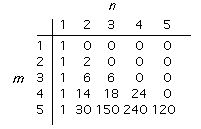(b) one-one correspondence
(c) one-one, not onto
(d) one-one, not onto
(e) one-one correspondence
(f) one-one, not onto
(g) Draw the graph to see that it is not one-one but is onto
(h) not one-one, not onto

Suppose f is one-one and let y ∈ f[A] ∩ f[B]. Then y = f (a) for a ∈ A and y = f (b) for b ∈ B. Thus f (a) = f (b) and by the one-one property, a = b

(b) Let x ∈ f[f -1[B]]. Then x = f (y) for y ∈f -1[B]. Hence f (y) ∈ B and we have f[f -1[B]] ⊆ f[B].

If f is onto, take y ∈ f[B]. Then y = f (b) for some b ∈ B. By the onto condition, b = f (a) for some a ∈ f -1[B] ⊆ X. Thus y ∈ f[f -1[B]] and the two sets are equal.

If the map is one-one we have a choice of n elements for the image of the first element of A, a choice of n - 1 for the second, etc. Thus we have n(n - 1)(n - 2) ... (n - m +1) = n!/m! one-one maps. (Of course, if m > n we get no such maps.)
 The number of onto maps is harder to calculate.
The number of onto maps is harder to calculate.
The number of onto maps from a set of size m to a set of size n are shown on the right for some small values.
These numbers are related to numbers discovered by the Scottish mathematician James Stirling (1692 to 1770).
If f: A→ B is a one-one map defined on a finite set A then the image of f has the same number of elements. Hence if |A| =|B| the map is onto. Example 1f) above shows that this result may fail for infinite sets.
Define a map from N × N × ... × N→ N by mapping (a1 , a2 , ... , an) to p1a1p2a2 ... pnan where p1 , ... , pn are distinct primes and the result follows in a similar way.
[Equivalently, a map from a set S to {0, 1} corresponds to a subset by mapping the elements of the subset to 1 and the other elements to 0. (This is called the characteristic function of the subset.) By question 3 above, there are 2n such maps.]
Hence the set of all finite subsets is ∪{subsets of size n} where the union is taken over all n ∈ N. This is a countable union of finite sets and hence is countable.

We can adapt the Cantor diagonalisation process as follows.
Suppose A1, A2 , A3 , ... is a counting of all the proper (≠ N) subsets of N.
Let X be the set {a1 , a2 , a3 , ...} where a1∉ A1 , a2∉ A2 , ...
Then the set X is not in the counting.
 Tabulating f as suggested gives a table as on the right:
Tabulating f as suggested gives a table as on the right:
This gives a one-one correspondence between N × N and N which is similar to (but not quite the same as) that given in the section on Infinity and infinities.
(One starts at the bottom of the line m + n = constant each time.)